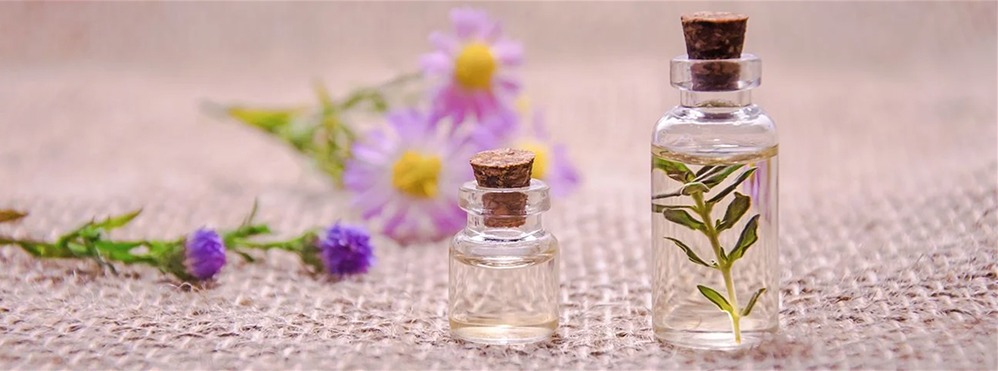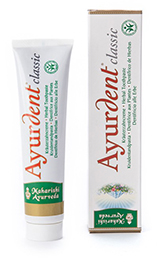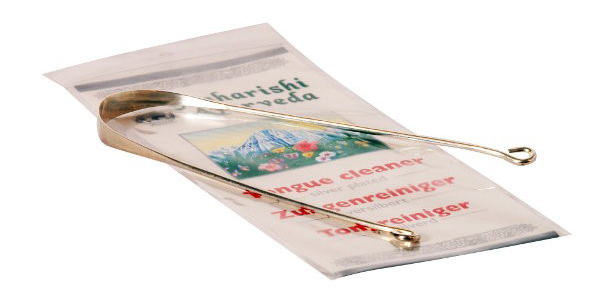Since thousands of years, Ayurveda has recommended that the tongue be cleaned after brushing the teeth and that the entire oral cavity be treated with oil in order to keep the mouth and teeth strong and healthy.
Brushing your teeth
Ayurvedic toothpaste is brownish, not white, because of its high content of medicinal herbal extracts. It contains no fluorides or foaming agents, because the mucous membrane of the mouth is so permeable that all substances in the mouth penetrate it and are quickly distributed throughout the entire organism via blood and lymph. Most important in the recipe of Ayurdent toothpaste are 20 organic Ayurvedic medicinal herbs, which have a tooth-caring, anti-inflammatory and strengthening effect and provide a pleasantly fresh breath.
Cleaning your tongue the Ayurvedic way with a tongue scraper
After brushing your teeth, Ayurveda recommends cleaning the surface of the tongue with a tongue scraper.
“Deposits that develop at the root of the tongue impair the sense of taste
and lead to bad breath. The tongue should therefore be cleaned regularly.”
Charaka Samhita, Sutrasthan 5, 75
A tongue scraper should be made of stainless steel or, even better, of silver, which is known to have bacteria-inhibiting properties. Cleaning the tongue has become so widespread in the West in recent years that even dental practices now offer tongue cleaners. However, avoid using a plastic tongue scraper, because micro-plastic particles are also absorbed into the organism through the mucous membrane of the mouth or swallowed directly. If you don’t have a tongue scraper at hand, you can also use a good-sized spoon.
The body detoxifies during the night
Especially during the night, a bacterial film builds up on the tongue. Also, Ayurveda tells us that the physiology eliminates a lot of Ama (a collective term for all kinds of metabolic residues and toxins) via the tongue. So it’s wise to make good use of the hard work the body has done, and not transport all the excreted material back into the intestines with the next breakfast!
No bad breath with Ayurveda
A study done in Toronto showed that cleaning the tongue reduces putrid gases and bad breath by about 75%, whereas usual tooth cleaning only reduces it by about 25%. Therefore, this mechanical removal of microorganisms plays a key role in controlling bad breath. Furthermore, it may help reduce caries incidence and strengthen dental health, similar to tooth brushing, according to the Association of Statutory Health Insurance Physicians of North Rhine-Westphalia.
Oil for dental health
All oils reduce Vata Dosha, which, when imbalanced, induces aging, dryness, and tissue breakdown. Balancing Vata Dosha by oiling the oral cavity reduces dryness of the mouth and makes for soft lips, even in cold weather. It reduces the teeth’s painful sensitivity to temperature, prevents tooth decay and brittle teeth. It improves blood circulation and thereby develops strong gums, prevents their recession and the loosening of teeth in the jaw. Regular oil swishing also prevents the formation of tartar, makes your teeth whiter in a completely natural way, and has a stabilizing effect on general health.
What the classical Ayurveda text by Charaka says:
“Rinsing the mouth with oil prevents dryness of throat and lips, protects the teeth, and strengthens the gums.”
“Carrying out mouth rinse with oil strengthens the jaw bones and the voice, develops the face and maximum taste of food … Teeth do not decay and become firmly rooted. There is no toothache nor sensitivity; the teeth can chew even the hardest food.”
Detoxification via the oral cavity
Tiny glands in the mucosa (lining) of the mouth constantly excrete deposits and toxins, eliminating them from the organism. To support this natural process, these substances can be bound with oil and then spit out into a cloth (not into the sink, as the oil might block the drain).
The classical texts recommend two different forms of oil application of the mouth and throat area.
Gandusha in the classical Ayurvedic sense
In Gandusha, one takes as much sesame oil in the mouth as one can hold – about 100 ml – so that the cheeks bulge outwards. This is held for a longer period of time, without moving the oil. For maximum effect, it is only spit out when a large amount of saliva has accumulated in the throat area and fluid begins to flow from nose and eyes.
According to the classical texts, this application reduces diseases, creates freshness, clarity and a feeling of lightness in the mouth. In addition, regular Gandusha improves the function of all sensory organs – not only the sense of taste, but also the sense of smell, sight and hearing. It also strengthens the voice, tautens the facial contours and reduces the formation of wrinkles in the cheek area.
Kavala Graha, Ayurvedic oil pulling
Gandusha’s little brother, called Kavala Graha in Ayurveda, has become popular in many countries in recent years. In English, it’s called oil pulling. In this procedure, you move a tablespoonful of oil around in your mouth for about five minutes, pushing and pressing it through the spaces between the teeth. At the end, you can gargle a little with it, which is especially beneficial for the throat and tonsils.
Gradually, the oil mixes with the saliva into an emulsion, so that it looks white when you spit it out. People with a tight daily schedule can do oil pulling while taking a shower, so that it doesn’t take any additional time.
Positive effects on the mouth and body
Ayurveda recommends Kavala Graha for strengthening gums and teeth and against bad breath and bleeding gums. The oil penetrates into interdental spaces and gum pockets and dissolves harmful bacteria sitting there, reduces plaque, and gently massages the gums when it’s pressed around in the mouth. A large proportion of the bacteria in plaque have a hydrophobic cell surface, which means that they repel water but bind to fatty substances. Therefore, they accumulate in the oil during oil pulling and are then easily removed.
Benefits for health in general
Further, as oil pulling affects the reflex zones of the tongue and extracts Ama from all parts of the mouth, it has a beneficial effect on the entire physiology. The stimulation of the salivary glands results in the release of enzymes that send a message to the digestive organs telling the stomach, intestines and liver to produce more enzymes. This enables the body to better remove old deposits and digest the food more thoroughly.
Regular oil pulling is helpful for the following conditions:
- All conditions where there is much Ama in the body: chronic fatigue, a feeling of heaviness, mental exhaustion, aching limbs or joints, digestive disorders, frequent headaches, migraines;
- Impure skin or blemished complexion;
- Weak immune system, frequent colds, bronchitis, thromboses, arthrosis, rheumatic diseases;
- Eczema, stomach ulcers, chronic intestinal conditions, heart and kidney problems, gynaecological diseases, nervous diseases, liver diseases.
Recommended: sesame oil
The composition of the fatty acids in sesame oil is beneficial for health and it also contains many minerals, trace elements, and lecithin.
Sesame oil plays a central role in Ayurvedic treatments, as it is slightly warming and thus stimulates the metabolism. Further, it penetrates the skin and mucous membranes faster and more thoroughly than other oils, which is why oil pulling with sesame oil is more effective than application with e.g. sunflower oil or other vegetable oils. Sesame oil strengthens the heart function, has a beneficial effect on cholesterol and osteoporosis, strengthens bones and teeth, and is ideal for a dry, flaky skin.
Curing sesame oil is easy
For an optimal effect, the oil should be cured by warming it to a temperature slightly above 100° centigrade.
If you don’t have a suitable thermometer, put the contents of a bottle of organic sesame oil into a saucepan and add two or three drops of water – not more! Now warm the oil over low or medium heat while keeping an eye on it. When (at about 100°C) the water drops evaporate with a soft but distinct “plop”, immediately take the oil off the heat. Let it cool down a little, then pour it back into the bottle.
You only need to cure the oil once, because the process permanently loosens the fatty acids’ bridge bonds. This means that the oil has become thinner and is absorbed faster and more easily through the cell gaps.

Adding essential oils to further support the immune system
To strengthen the cleansing effect of oil pulling, essential oils can be added to the cured sesame oil. This creates variety in your daily routine and can be used to specifically strengthen the immune system.
Very suitable are tea tree oil, peppermint oil, lemon oil, cinnamon bark oil or sea buckthorn pulp oil. These oils are antibacterial, antiviral, some also antifungal, and can be used specifically during the cold season or in case of immunodeficiency.
For this purpose, add a drop of the essential oil of your choice to the tablespoonspul of sesame oil you use for oil pulling.
Alternatively, you can also prepare a larger quantity of oil in advance.
For example:
- 100 ml cured sesame oil
- 5-10 drops of peppermint oil
- 8-12 drops of lemon oil
- 15 drops of sea buckthorn pulp oil
- optionally 5 drops of tea tree oil
Adjust the amount of each oil as per your personal preference.
When buying essential oils, make sure they are of very high quality. Food quality is best, as these oils are absorbed into the body through the oral mucosa lining the mouth. Oils that are only intended for scenting are not suitable for this purpose.
Sea buckthorn fruit pulp oil can also be used in case of gum inflammation or aphthae: apply it undiluted with a cotton swab. The taste is very pleasant and it’s a wonderful balm for your gums.
What modern science says
Especially in recent years, we have seen modern scientific studies on oil pulling, since this millennia-old practice is gaining popularity in the West and is now also being recommended more and more by dentists.
The overall conclusion of comprehensive meta-analyses was that daily oil pulling reduced bad breath within two weeks, while at the same time the amount of bacteria in saliva and plaque decreased significantly. Oil pulling can also greatly reduce plaque-induced gingivitis (inflammation of the gums) just like commercial disinfecting mouthwashes.
Good breath throughout the day
A natural way to keep your breath fresh is chewing certain spices after a meal. For example, you can take aniseed and fennel seeds, cardamom and cloves. These spices not only have a cleansing and disinfecting effect, they also taste good and stimulate the digestive system. The same is achieved with an Ayurvedic mouthwash.
J Ayurveda Integr Med. 2011 Apr;2(2):64-8.doi: 10.4103/0975-9476.82525.
Tooth Brushing, Oil Pulling and Tissue Regeneration: A Review of Holistic Approaches to Oral Health
Int J Health Sci (Qassim). Sep-Oct 2017;11(4):65-70.
Oil Pulling and Importance of Traditional Medicine in Oral Health Maintenance
Download this article as a PDF file
© Maharishi AyurVeda Privatklinik Bad Ems


